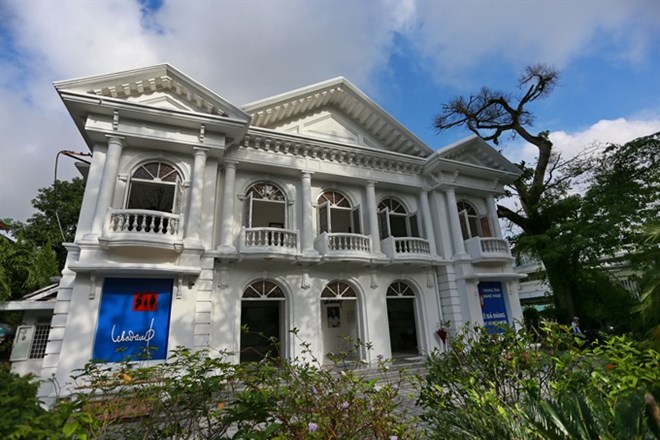
Researchers in the former imperial capital city of Hue have voiced their concerns over the new list of 27 prominent ’Indochinese colonial-style’ architectural buildings in the city.
The building designated for artist Le Ba Dang (Photo: VNA).
According to them, the list includes buildings that are not made in the colonial style while it excludes several buildings built during the French colonial period in the city. The researchers have demanded the elimination of those buildings from the list that have not maintained their status quo due to recent conservation work.
Phu Cam Cathedral, which is included in the list, is said to have a contemporary architectural style. "The cathedral was originally built in the colonial style, but it was knocked down in 1960 to be constructed into a new building, which was completed in 2000. Hence, it cannot be a colonial building,” said researcher Nguyen Xuan Hoa, former director of the local Department of Culture.
He added that the Morin Hotel and Memorial Pavilion for World War Martyrs should also be removed from the list due to changes in their structures and colours.
The original Morin Hotel was built in 1901 with two floors, but later in the 2000s, it was upgraded to four storeys. The Memorial Pavilion was built in 1920, with the inscription bearing the names of 78 Vietnamese and 31 French who had died during World War I. However, conservation work in 2017 destroyed all the inscriptions and changed the colour as well as many architectural patterns on the memorial.
Researcher Tran Dinh Hang, Director of the Vietnam Institute for Culture and Arts Studies in Hue, agreed with Hoa and said the Memorial Pavilion should not be included in the list as it had been changed.
Hoa, meanwhile, questioned why a 100-year-old typical colonial building, located on Le Loi Street, was not included in the list. This building serves as the office of the local Association of Culture and Art. "It is a typical, beautiful building and was the landmark of cultural historical events in Hue,” Hoa said.
The building is listed as one of the targets to be demolished to acquire land for a hotel.
Hang expressed his reservations about the list prepared by the provincial People’s Committee, which said the list was to enhance the conservation of the colonial buildings in the city. Hang said several colonial buildings that were not included in the list were targeted for demolition.
Earlier this month, the provincial People’s Committee had announced a list of 27 prominent Indochinese colonial-style buildings, saying that these buildings will be protected from land revamp for business structures.
Buildings in the list include those built by French colonialists, such as the railway station, Quoc Học School where President Ho Chi Minh used to study, it’s neighbour Hai Ba Trung School and the twin buildings that serve as offices of the Hue Museum of Culture.
Hang said the committee’s efforts to recognise the colonial buildings came late as tens of typical colonial buildings on the streets of Le Loi, Hoang Hoa Tham and Ly Thuong Kiet had already been knocked down to construct new buildings.
According to a study of the Central Region Institute for Constructional Science and Technology, there are some 200 colonial buildings located around Hue. Colonial buildings are part of the architectural history of the city, but few have maintained their original architecture due to changes in the trends of construction.-
Source: VNA
Phong Phu commune, Tan Lac district of Hoa Binh province, is widely regarded as the cultural heartland of the Muong ethnic group. Among its many traditional communities, Luy Ai hamlet (formerly Ai hamlet) stands out as a rare location where the customs and way of life of the Muong Bi people remain largely intact.
The Truong Kha temple festival, a distinctive cultural event held every three years in Vu Ban township, Lac Son district, returned recently with vibrant rituals and folk traditions of the Muong people. Located next to the Buoi River in the Muong Trao fields, the Truong Kha Temple is dedicated to the three Kun Dol deities, revered for teaching farming techniques, irrigation, weaving, and protecting the harvest.
The demand for spaces serving community activities of residents in various areas across Hoa Binh city has been satisfied as local cultural houses now feature modern, spacious facilities thanks to the effective implementation of Resolution No. 49/NQ-HDND issued on December 28, 2021 by the city People's Council, which approved the plan for reorganising, converting, and allocating land for the construction, repair, and expansion of cultural houses in Hoa Binh’s villages and residential areas until 2025.
At the end of May, the Hoa Binh Provincial Ethnic Arts Troupe organized a series of performances for residents in Region 2 and Region 3 communes across the province. Bringing art to ethnic communities in remote, isolated, and especially disadvantaged areas has become a meaningful activity. These are not merely artistic performances but also journeys to disseminate cultural values, enrich spiritual life, and contribute to preserving the cultural identity of ethnic minorities.


